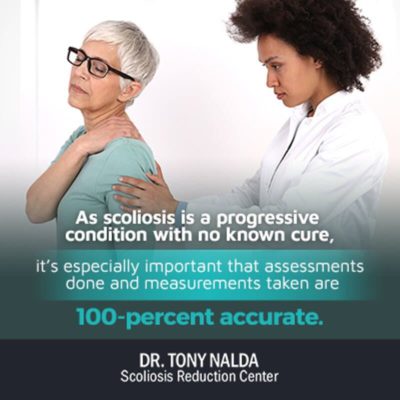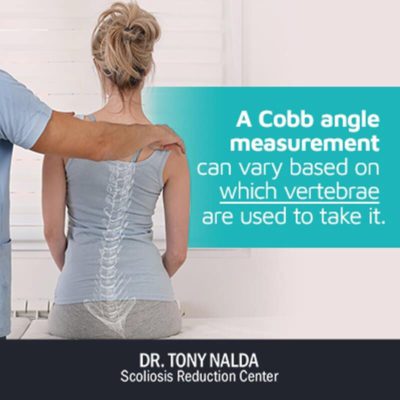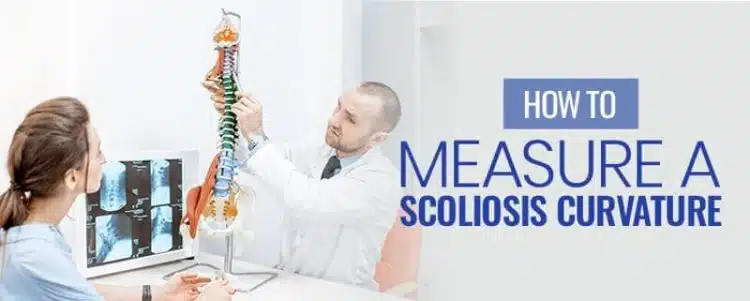Scoliosis, a condition characterized by an abnormal curvature of the spine, affects individuals in varying degrees of severity. Understanding the extent of this curvature is crucial for determining the most appropriate course of treatment.
In order to classify a patient’s scoliosis as mild, moderate, or severe, a measurement known as the ‘Cobb angle’ will be taken via X-ray. The Cobb angle measurement uses the apex of the curve to determine how much the scoliosis curvature deviates from a straight alignment.
Below, we delve into the specifics of how the Cobb angle is measured and its significance in the management of scoliosis. By comprehending this fundamental aspect of diagnosis, patients and caregivers can better navigate the complexities of treatment options and prognoses associated with this spinal condition.
4 Key Takeaways
- Cobb Angle as a Diagnostic Tool: The Cobb angle, measured via X-ray, is crucial for assessing the severity of scoliosis by determining the extent of spinal deviation. This measurement is foundational for classifying the condition as mild, moderate, or severe, thereby guiding treatment decisions.
- Importance of Specialist Interpretation: Given scoliosis is a 3-dimensional condition, the interpretation of 2-dimensional X-ray images requires expertise. Specialists in scoliosis can accurately assess these images to understand the spine’s condition fully, ensuring a more effective treatment plan.
- X-Ray’s Role in Comprehensive Assessment: While X-ray technology remains the most reliable and accessible method for diagnosing scoliosis, it’s essential to use it alongside assessments from multiple angles for a complete understanding of the spine’s 3-dimensional deviation.
- Scoliosis Treatment Customization: Accurate and comprehensive scoliosis assessments, including the Cobb angle measurement, enable the customization of treatment plans. These tailored approaches significantly increase the chances of reducing curvature and improving patients’ quality of life.
Here’s a video that goes more into this topic:
https://www.youtube.com/watch?v=flVJ0775Ykw
The Scoliosis X-Ray
Although receiving a scoliosis diagnosis can be frightening, the condition is highly treatable. Here at the Scoliosis Reduction Center®, we’ve had the pleasure of supporting patients on their journey from diagnosis to successful treatment.
Whether a patient comes to us for a diagnosis or help with a pre-existing condition, if they’re willing to fully commit to a customized treatment plan, we can offer them the greatest chances of reducing their curvature and improving their quality of life.
Before any of those positive treatment options can start, an accurate condition assessment and curvature measurement must be taken, and this is done with a scoliosis X-ray
When it comes to assessing a patient’s condition and designing the best possible treatment plan, a scoliosis X-ray is “the gold standard”. A scoliosis X-ray can tell me everything I need to know regarding the specifics of a patient’s curvature.
When a scoliosis X-ray is administered and assessed by an expert with scoliosis-specific experience and training, the information it provides can make real change possible.
X-Ray as the Assessment and Diagnostic Tool of Choice
In this modern digital age, there’s no shortage of new fandangled medical equipment and tools, but still, X-ray remains the most reliable, accurate, inexpensive, and accessible method for diagnosing and assessing scoliosis.
Although there are other options such as 3-D X-ray technology, it’s expensive, time-consuming, and depends on the patient remaining completely still throughout the exam; you can imagine how problematic that is when the patients are children.
Standing MRI scans are another option, but they are far more expensive than a traditional X-ray and the results they produce are no more reliable or accurate.
The main drawback of a scoliosis X-ray is that it can only produce 2-dimensional images of a 3-dimensional condition; however, that is only a shortfall, if the person performing the assessment is not a scoliosis specialist.
Why it’s Important to Work with a Scoliosis Specialist
Scoliosis is a complex condition whose causes are far from fully understood. One thing we do know is that it’s a 3-dimensional condition as the spine doesn’t just bend backwards or forwards, left or right; instead, it bends, curves, and rotates in several directions.
What this means, in terms of reading a scoliosis X-ray comprehensively, is that it’s critically important that the person reading the X-ray knows how to interpret it so that the best possible treatment plan can be addressed.
Experts who specialize in scoliosis are experienced in using X-rays taken from multiple angles so they can get a complete understanding of what’s happening with the patient’s spine on all three dimensions.
When it comes to designing an effective treatment plan, working with a specialist has a lot of advantages. Most doctors don’t specialize in scoliosis. While a general practitioner can certainly diagnose an abnormal spinal curvature, it’s likely that they lack the experience necessary to comprehensively interpret a scoliosis X-ray, precisely measure the curvature, and make the proper recommendations based on the results.
If you or a loved one is facing scoliosis, you’ll want an expert’s eye on your side.
The Scoliosis Reduction Center® Approach to the Scoliosis X-ray

As scoliosis is a progressive condition with no known cure, it’s especially important that assessments are done and measurements taken are 100-percent accurate.
Here at the Scoliosis Reduction Center®, every doctor here has the training, experience, and certifications in scoliosis-specific treatment.
When we take an X-ray, we assess what’s happening with the spine from multiple X-ray angles; by doing this, our curvature measurements can include the spine’s twist, tilt, and any other important factors.
I use scoliosis X-rays as a daily part of my diagnostic, monitoring, and treatment approach. I’m proud to say that my practice has the latest digital scoliosis X-ray technology that provides the most accurate results, with the least possible exposure to radiation. Our specifically-targeted X-rays assess the spine’s biomechanical integrity, allowing us to reach more precise measurements.
Over the years, I’ve taken thousands of scoliosis X-rays. In that time, I’ve honed the ability to interpret them with precision and accuracy, and this ability means being able to craft a more customized and effective treatment plan.
How we Use Scoliosis X-Rays
We use scoliosis X-rays in a variety of ways throughout the treatment process. We use them first to diagnose a condition and place it on the severity scale. Then we use them to assess the patient’s condition from a variety of angles; we do this so we can see what’s happening with the spine from every angle.
In terms of treatment, we use scoliosis X-rays to monitor the condition’s progression or progress, as the case may be, apply specific chiropractic adjustments, and prescribe helpful exercises. We do all this to gauge how the patient’s condition is responding to the chosen treatment approach and make adjustments as needed.
Cobb Angle
The Cobb angle is the most accepted method for measuring a scoliosis curvature. It’s taken during a scoliosis X-ray and expresses the degree to which the spine bends, curves, and rotates away from a straight alignment. It’s measured by finding the vertebrae (spinal bones) with the most tilt in each curve.
To take the measurement, lines are drawn at the top of the superior tilted vertebra and the base of the inferior tilted vertebra. Next, two additional lines are drawn at a 90-degree perpendicular angle to the first lines so they intersect.
The angle produced is measured and expressed in numerical degrees. Once the Cobb angle measurement is determined, the condition can be placed on a severity scale from mild to severe:
- Mild scoliosis: Cobb angle measurement of 25 degrees or less
- Moderate scoliosis: Cobb angle measurement between 25 and 40 degrees
- Severe scoliosis: Cobb angle measurement of 40+ degrees for adolescents and 50+ degrees for adults
Generally, a minimum Cobb angle measurement of 10 degrees is required to reach a scoliosis diagnosis. The Cobb angle is an essential piece of information in terms of both classifying and treating a patient’s condition.
Shortcomings of a Cobb Angle Measurement
While a Cobb angle measurement is an essential piece of information, there are some key points any proactive patient, or their caregivers should be aware of.
A 3-Dimensional Condition Measured in a 2-Dimensional Space
As previously mentioned, a Cobb angle is not the only piece of information needed to come up with a comprehensive individualized treatment plan. A Cobb angle measurement on its own doesn’t paint a complete picture of what’s happening with the spine on all 3 dimensions because it’s a measurement taken of a 2-dimensional space.
A Cobb angle measurement that’s combined with the results of X-ray images taken from multiple angles is what’s necessary to comprehensively understand a patient’s condition in a 3-dimensional manner.
Cobb Angle Measurements can Vary

A Cobb angle measurement can vary based on which vertebrae are used to take it. Don’t be afraid to confirm with your doctor that the same vertebrae are used every time the Cobb angle is being assessed.
There are also differences in how one doctor draws the measurement lines compared to another, and this can alter the final Cobb angle measurement. If two X-rays are being compared, especially if taken by different doctors, a variation could be due to the differences in how the doctors took the measurements, rather than an actual change to the spine.
The Cobb angle measurement is an important piece of information when it comes to deciding how to move forward with treatment; as such, patients and their caregivers should be informed on the right questions to ask to ensure the most precise possible measurements are being used to determine the best treatment path.
Conclusion
Measuring the degree to which a patient’s spine bends, twists, and rotates away from a straight alignment is important for multiple reasons.
Firstly, the Cobb angle measurement tells us how severe a patient’s curvature is. Secondly, it tells us where the condition places on the severity scale. Thirdly, it helps us classify the condition so we can best treat it.
In addition to the Cobb angle, a scoliosis curvature has to be assessed from a variety of angles; this is important because X-ray images are measurements taken of a 2-dimensional space, but scoliosis is a 3-dimensional condition.
When interpreted comprehensively by a scoliosis expert, a scoliosis X-ray can tell us everything we need to know to move forward in treating the patient’s condition. For that reason, here at the Scoliosis Reduction Center®, we use only the latest and greatest in X-ray technology.





